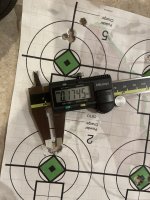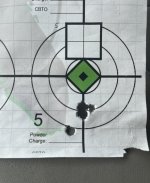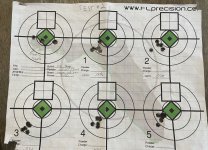I currently have a 6.5cm load that shoots lights out. Problem is it's just shy of meeting the power factor for NRL Hunter. Im running 140 bergers at 2680.
I attempted load development this time by looking for optimal seeing depth first, then fine tuning with powder. As I've read, most rifles have an lower and upper accuracy node. Question, is seating depth typically constant regardless of upper or lower powder node?
No.
For you that start your load dev. with seating depth, what is your process? I've read the Burger VLD process but wonder what others are having success with.
From the
Berger website: Load 24 rounds at the following COAL if you are a target competition shooter who does not worry about jamming a bullet:
1. .010 into (touching) the lands (jam) 6 rounds
2. .040 off the lands (jump) 6 rounds
3. .080 off the lands (jump) 6 rounds
4. .120 off the lands (jump) 6 rounds
Load 24 rounds at the following COAL if you are a hunter (pulling a bullet out of the case with your rifling while in the field can be a hunt ending event which must be avoided) or a competition shooter who worries about pulling a bullet during a match:
1. .010 off the lands (jump) 6 rounds
2. .050 off the lands (jump) 6 rounds
3. .090 off the lands (jump) 6 rounds
4. .130 off the lands (jump) 6 rounds
Shoot 2 (separate) 3 shot groups in fair conditions to see how they group. The remarkable reality of this test is that one of these 4 COALs will outperform the other three by a considerable margin. Once you know which one of these 4 COAL shoots best then you can tweak the COAL +/- .002 or .005. Taking the time to set this test up will pay off when you find that your rifle is capable of shooting the VLD bullets very well (even at 100 yards).
Berger LR Target 140s
Lapua brass (virgin)
#450
H4350 40.7gr
.057 jump
2680 ft/sec
Keep in mind that whatever one's jump is, it doesn't tell anything about seating depth because:
. . . different comparator inserts used for jump measurements vary where there can be as much as .040 or more difference.
. . . different chambers have different dimensions. Like, one might have a chamber with a freebore of .167 while someone else's freebore might be .221 or maybe .124 and the .057 jump would be a very different seating depth between those chambers.
It's better to inform about COAL to get a better idea of how a cartridge is actually set up (even though there some variation in bullets OAL).



